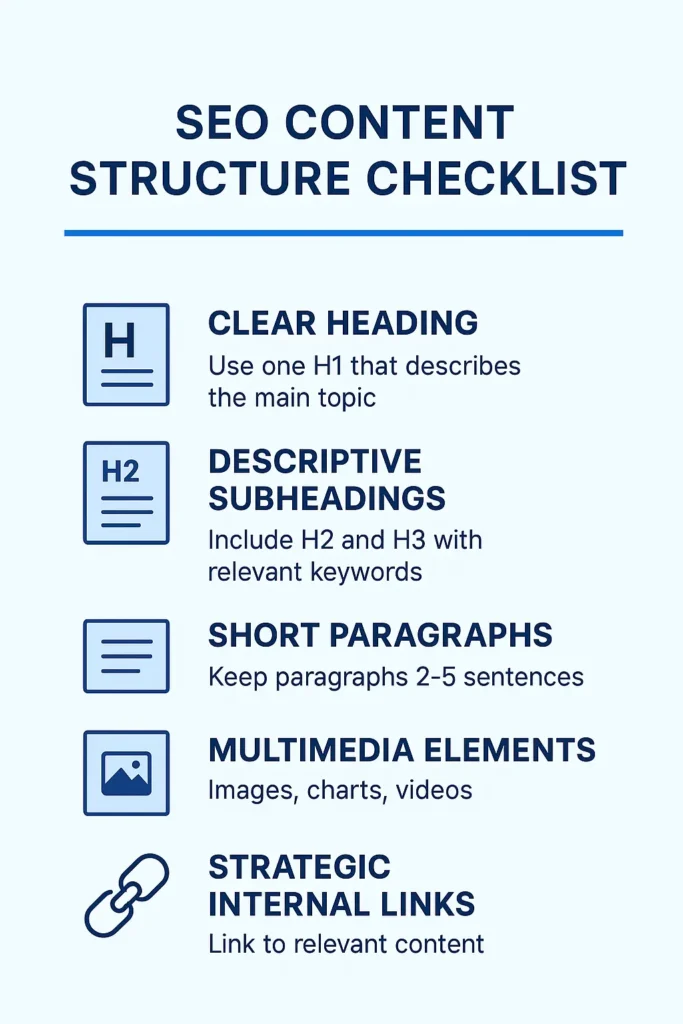In the competitive world of digital marketing, creating content isn’t enough. The way your content is structured can significantly impact your website’s search visibility. Search engines like Google don’t just look for keywords—they evaluate how easily users can navigate, understand, and engage with your content. This is where insights from tools like SEOsets can help marketers optimize content structure for maximum SEO impact.
Understanding Content Structure and Its Importance
Content structure refers to how information is organized and presented on your website. Well-structured content enhances user experience and guides search engines in understanding your page’s relevance. Key components include:
- Headings and Subheadings: Proper use of H1, H2, and H3 tags ensures content is scannable and hierarchical.
- Paragraphs and Lists: Breaking information into digestible segments improves readability.
- Internal Linking: Helps distribute link equity and signals important pages to search engines.
- Multimedia Elements: Images, videos, and infographics support engagement and contextual understanding.
Poor structure can lead to higher bounce rates, lower dwell time, and ultimately, weaker search performance. Optimizing content structure is crucial for aligning with Google’s algorithms while keeping readers engaged.
Using SEOsets Insights to Refine Content Structure
SEOsets provides actionable insights to improve content organization and SEO performance. Here’s how you can leverage these insights:
1. Keyword Placement and Hierarchy
Keyword research often focuses on which terms to target. However, their placement within your content structure is equally important. SEOsets insights help you identify:
- Primary and secondary keywords for each page
- Optimal locations for keywords, such as headings, first paragraph, and metadata
- Semantic variations to naturally integrate into subheadings
By strategically placing keywords in a clear hierarchy, search engines can better understand your content while maintaining readability for users.
2. Optimizing Headings for Search Intent
Headings guide readers and search engines through your content. SEOsets can reveal how competitors structure their headings, giving you insights to:
- Align your headings with user search intent
- Include relevant long-tail keywords in H2 or H3 tags
- Ensure the content flow answers questions logically
For example, if users are searching for “content structure tips for SEO,” including an H2 like “Practical Tips to Optimize Content Structure for SEO” signals relevance and improves your chances of ranking.
3. Content Gap Analysis
Understanding what your content is missing compared to top-ranking pages is essential. SEOsets insights allow you to:
- Identify missing topics or subtopics
- Analyze competitor keyword density
- Incorporate these findings into your content naturally
Filling content gaps not only strengthens your authority but also provides comprehensive answers, which search engines favor.
4. Enhancing Internal Linking
Internal links guide search engines and users to key pages, distributing link equity across your site. SEOsets can:
- Highlight pages that require more internal links
- Suggest anchor text optimized for keywords
- Reveal orphaned pages that need connectivity
A strong internal linking strategy improves indexation, authority, and user navigation.
5. Improving Readability and Engagement
Search engines reward content that keeps users engaged. SEOsets insights can analyze:
- Average paragraph length and sentence structure
- Use of multimedia elements for visual engagement
- Content formatting, including bullets, numbered lists, and tables
Optimizing readability reduces bounce rates and increases dwell time, both of which positively influence search rankings.
Best Practices for Structuring Content
Based on SEOsets insights and general SEO principles, here are actionable strategies to structure content effectively:
- Start with a Clear H1: Every page should have one H1 that clearly represents the main topic.
- Use Descriptive Subheadings: H2s and H3s should outline sections logically and include relevant keywords.
- Short Paragraphs: Keep paragraphs between 2-5 sentences for easier reading.
- Incorporate Multimedia: Use images, charts, and videos to explain concepts and increase engagement.
- Strategic Internal Links: Link related content naturally within your text.
- Optimize Meta Elements: Titles, meta descriptions, and alt text should reflect the content structure.
Monitoring and Adjusting Content
Optimizing content structure isn’t a one-time task. SEOsets allows continuous monitoring of your content’s performance by:
- Tracking ranking improvements for targeted keywords
- Measuring engagement metrics like time on page and bounce rate
- Identifying sections that need updates or expansion
Regular updates based on these insights ensure your content remains relevant and competitive.
Call to Action
For businesses looking to elevate their SEO strategy, tools like SEOsets provide the insights necessary to optimize content structure effectively. Leveraging these insights can transform your content into a search-engine-friendly powerhouse, driving more traffic and engagement.
FAQs
Q1: What is content structure in SEO?
Content structure refers to how your information is organized on a page, including headings, subheadings, paragraphs, lists, and internal links. Proper structure improves readability and search engine understanding.
Q2: How can SEOsets help optimize content structure?
SEOsets provides insights on keyword placement, heading optimization, internal linking, content gaps, and readability metrics, helping you structure content for both users and search engines.
Q3: Does content structure affect rankings?
Yes. Well-structured content improves user experience, reduces bounce rates, and helps search engines index and understand your content better, positively impacting rankings.
Q4: How often should I review my content structure?
Content should be reviewed regularly, especially when updating for new keywords, trends, or competitor changes. SEOsets can track performance and highlight areas needing improvement.
Q5: Can multimedia improve SEO?
Absolutely. Images, videos, and infographics increase engagement, provide context, and enhance the content’s value, indirectly boosting search performance.


